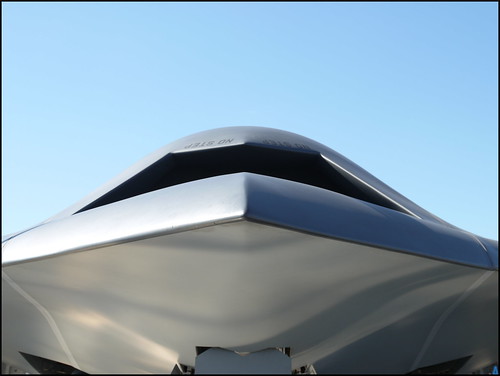The next generation of American UAV on display at the Farnborough Air Show. An unmanned aerial vehicle (UAV) is an unpiloted aircraft. UAVs can be remote controlled or fly autonomously based on pre-programmed flight plans or more complex dynamic automati by Swamibu
The Pentagon is rapidly improving its ability to fight wars with robots. This capability is "bringing about the most profound transformation of warfare since the advent of the atom bomb," says Scientific American, and raises "a host of ethical and legal issues."
"Robots are pouring onto battlefields as if a new species of mechanotronic alien had just landed on our planet," the publication says in an editorial on their development in its July issue. "The prospect of androids that hunt down and kill on their own accord (shades of Terminator) should give us all pause. An automatic pilot that makes its own calls about whom to shoot violates the "human' part of international humanitarian law, the one that recognizes that some weapons are so abhorrent that they just should be eliminated."
Since 2003, 7,000 unmanned aircraft and 12,000 ground vehicles have entered the U.S. military inventory, "entrusted with missions that range from seeking out snipers to bombing the hideouts of al-Qaeda higher-ups in Pakistan," writes P.W. Singer in an accompanying article titled "War of The Machines."
Singer, who directs the 21st Century Defense Initiative at The Brookings Institution, in Washington, D.C., a non-profit research think tank, says robots include:
# Lockheed Martin's High-Altitude Airship, an unmanned blimp that carries a radar the length of a football field and can fly at nearly 19,800 meters for over a month at a time.
# Contractor QinetiQ North America's MAARS robot, resembling a tank that is armed with a machine gun and grenade launcher that does sentry and sniper duty.
# The miniature surveillance "bot" from contractor AeroVironment that "mimics a hummingbird in size and its ability to hover over a target" and which flaps its wings frenetically as its cameras observe a scene.
# The Counter-Rocket Artillery and Mortar, or C-RAM, which resembles Star Wars robot R2-D2 and is armed with a machine gun that can shoot down incoming missiles and is used to protect the Green Zone in Baghdad.
# The TALON ground robot that can defuse bombs and peeks over obstacles to hunt for enemies.
# The ChemBot, conceived by the University of Chicago and contractor iRobot, of Bedford, Mass., and which is "a bloblike machine that shifts shape, such that it is able to squeeze through a hole in the wall."
# The Predator drone that can track 12 targets at once and which has been used in combat since 1995. This unmanned aerial vehicle(UAV) from General Atomics is armed with two lethal Hellfire missiles that have killed as many as 40 al-Qaeda leaders but which, by some estimates, have killed as many as 1,000 civilians across Iraq, Afghanistan and Pakistan.
Author Singer writes that robots are machines built to operate in a "sense-think-act" paradigm. Information from their sensors is relayed to computer processors or artificial intelligence software that decide whether to activate their mechanical "effectors."
"The global Positioning Satellite system, video-game-like remote controls and a host of other technologies have made robots both useful and usable on the battlefield during the past decade," Singer writes. "The increased ability to observe, pinpoint and then attack targets in hostile settings without having to expose the human operator to danger became a priority after the 9/11 attacks," he writes.
What's more, Singer intimates that we ain't seen nothin' yet. "The inexorable growth in computing power means that today's recently enlisted soldiers may end their careers witnessing robots powered by computers literally a billion times more capable than those currently available," he writes.
In an editorial titled "Terminate the Terminators," Scientific American warns, "Some might call a ban on autonomous robots naà �ve or complain that it would tie the hands of soldiers faced with irregular warfare. But although robots have clear tactical advantages, they carry a heavy strategic price."
(Note: You can view every article as one long page if you sign up as an Advocate Member, or higher).





